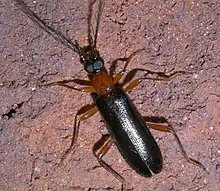Dendroides canadensis
Dendroides canadensis, the fire-colored beetle, is a species of fire-colored beetle in the family Pyrochroidae from southeastern Canada and the eastern and central United States. This beetle has both the adaptations of freezing tolerance and freezing susceptibility (supercooling).
| Dendroides canadensis | |
|---|---|
 | |
| Adult male | |
 | |
| Adult female | |
| Scientific classification | |
| Domain: | Eukaryota |
| Kingdom: | Animalia |
| Phylum: | Arthropoda |
| Class: | Insecta |
| Order: | Coleoptera |
| Infraorder: | Cucujiformia |
| Family: | Pyrochroidae |
| Genus: | Dendroides |
| Species: | D. canadensis |
| Binomial name | |
| Dendroides canadensis Latreille, 1810 | |
Description
The adult Dendroides canadensis is from 7 to 16 mm (0.28 to 0.63 in) long. The head and elytra are black, while the thorax and legs are reddish-brown. The antennae are pectinate (comb-like), and the compound eyes are very large, being contiguous in the male and almost united in the female. The larvae are whitish grubs with light tan heads; their urogomphi (spines on the last segment) are not recurved but are relatively straight.[1][2]
.jpg.webp) Larva
Larva Pupa
Pupa
Distribution and habitat
Dendroides canadensis is found in eastern North America, its range extending from Manitoba and Nova Scotia in Canada to Oklahoma and Florida in the United States. The adults are active at night, are attracted to lights, and can be found among foliage.[3] The larvae live under the bark of the upper and side surfaces of fallen trees and branches.[1]
Physiology
Native to Northern Indiana,[4] this species has both the adaptations of freezing tolerance—that is, keeping body fluids above crystallization temperatures between −8 and −12 °C (18 and 10 °F)—and freezing susceptibility (supercooling)—that is, surviving with ice in the body up to −26 °C (−15 °F). This is the first known instance of overwintering by switching between the two mechanisms. [4][5][6] In response to decreasing temperatures in the fall, D. canadensis larvae cease eating and drinking, and they evacuate the gut. In order to avoid mortality, other body fluids also need to remain liquid, and D. canadensis increases the antifreeze proteins in its hind-gut and primary urine at this time.[7]
Its antifreeze molecules are similar to those used by the mealworm Tenebrio molitor, but they are quite distinct from antifreeze molecules used by any known fishes.[8] Multiple types of antifreeze in simultaneous use complement each other and enhance the process.[9] These have been used in studies to help raise cold resistance in plant species.[10]
References
- "Species: Dendroides canadensis". BugGuide. Retrieved March 25, 2021.
- "Genus: Dendroides". BugGuide. Retrieved March 25, 2021.
- Young, Daniel K. (1983). A Catalog of the Coleoptera of America North of Mexico: Family: Pyrochroidae. U.S. Department of Agriculture. p. 4.
- Duman, John G. (March 1, 1980). "Factors involved in overwintering survival of the freeze tolerant beetle, Dendroides canadensis". Journal of Comparative Physiology. 136 (1): 52–59. doi:10.1007/BF00688622. S2CID 36293443.
- Horwath, Kathleen L.; Duman, John G. (January 1, 1984). "Yearly variations in the overwintering mechanisms of the cold-hardy beetle Dendroides canadensis". Physiological Zoology. 57 (1): 40–45. doi:10.1086/physzool.57.1.30155965. S2CID 85643212.
- Vernon, Philippe; Vannier, Guy (2002). "Evolution of freezing susceptibility and freezing tolerance in terrestrial arthropods". Comptes Rendus Biologies. 325 (12): 1185–1190. doi:10.1016/S1631-0691(02)01536-6. PMID 12520868.
- Nickell, Philip K.; Sass, Sandra; Verleye, Dawn; Blumenthal, Edward M.; Duman, John G. (2013). "Antifreeze proteins in the primary urine of larvae of the beetle Dendroides canadensis". Journal of Experimental Biology. 216 (9): 1695–1703. doi:10.1242/jeb.082461. PMID 23348942.
- Duman, J. G.; Li, N.; Verleye, D.; Goetz, F. W.; Wu, D. W.; Andorfer, C. A.; Benjamin, T.; Parmelee, D. C. (April 1, 1998). "Molecular characterization and sequencing of antifreeze proteins from larvae of the beetle Dendroides canadensis". Journal of Comparative Physiology B. 168 (3): 225–232. doi:10.1007/s003600050140. PMID 9591363. S2CID 26511456.
- Wang, Lei; Duman, John G. (August 1, 2005). "Antifreeze proteins of the beetle Dendroides canadensis enhance one another's activities". Biochemistry. 44 (30): 10305–10312. doi:10.1021/bi050728y. PMID 16042407.
- Huang, Tao; Nicodemus, Jessie; Zarka, Daniel G.; Thomashow, Michael F.; Wisniewski, Michael; Duman, John G. (October 1, 2002). "Expression of an insect (Dendroides canadensis) antifreeze protein in Arabidopsis thaliana results in a decrease in plant freezing temperature". Plant Molecular Biology. 50 (3): 333–344. doi:10.1023/A:1019875922535. PMID 12369611. S2CID 12076944.
Further reading
- Lobl, I.; Smetana, A., eds. (2013). Catalogue of Palaearctic Coleoptera, Volume 5: Tenebrionoidea. Apollo Books. ISBN 978-90-04-26090-0.
- "Dendroides canadensis Report". Integrated Taxonomic Information System. Retrieved September 24, 2019.
- "Dendroides canadensis". GBIF. Retrieved September 24, 2019.
- "Dendroides canadensis species Information". BugGuide.net. Retrieved September 24, 2019.
External links
 Media related to Dendroides canadensis at Wikimedia Commons
Media related to Dendroides canadensis at Wikimedia Commons- Molecular sequence encoding the Dendroides canadensis antifreeze molecules